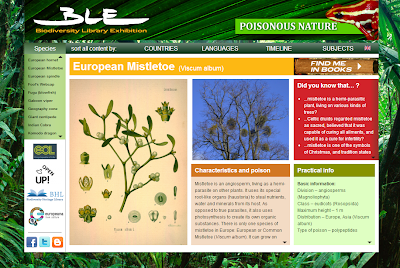Officially, the BHL-Europe project already came to an
end on 30 April. But for the BHL-Europe consortium members, the end came last
week – after the final meetings and final review of the project in Berlin. It’s safe to say
we went out with a bang… Here’s a recap of the final events, which included a
symposium on the Convention on Biological Diversity, a BHL-Europe “Show and
Tell”-moment and the final review!
 |
| BHL-Europe
team in Berlin 2012 |
4
June 2012 – Communicating Biological Diversity
The first day saw the organization of a
symposium on the topic of the Convention on Biological Diversity (CBD), which
was adopted 20 years ago. We had
speakers covering a broad range of aspects concerning the CBD implementation.
Collaboration and integration are equally important for scientists and policy
makers. We need a science-policy dialogue facilitated by a network of
knowledge, where also BHL-Europe need to be part of via IPBES, the
Intergovernmental Platform on Biodiversity & Ecosystem Services (http://www.ipbes.net/). Global collaboration
is necessary to facilitate knowledge, data and technology sharing, which also
requires standardization. Another aspect is participation and training: we need
scientific literate citizens all over the world to support the discovery of
biodiversity and its sustainable use. We have seen tools and projects during
the day that demonstrate a successful collaboration between experts and
citizens. Acknowledging the importance of
citizen participation should not forget the work of taxonomists that need the
right credit and support to deliver high quality biodiversity information.
 |
| Dinosaur
hall of the Museum für Naturkunde |
At night, a reception was held in the
majestic dinosaur hall of the Museum für Naturkunde. BHL-Europe collaborators
shook hands and mingled, while they ate, discussed the project or engaged in
small talk.
5 June 2012 – BHL-Europe
Show & Tell
On Tuesday 5 June, the BHL-Europe Show and
Tell was held, which mainly consisted of a roundup of the major milestones
achieved over the course of the project. Henning
Scholz of the Museum für Naturkunde kicked off a series of
presentations, praising the consistency of the staff and the technical
developments. He once again underlined BHL-Europe’s mission to make biodiversity
knowledge available globally to anyone, which can now be achieved thanks to
BHL’s high quality network of libraries, developers, taxonomists etc.
 |
BLE and
posters section in main meeting hall of Jerusalem Church
|
Martin Kalfatovic of the Smithsonian Institute Libraries gave the next presentation,
focusing on the Global BHL. He explained to us that BHL now has about 1.6
million users from a staggering 233 countries! Martin was followed by Lizzy Komen of Europeana, who among other things
highlighted some of the content and several other Europeana projects, such as a
collaboration with Wikipedia. Presentations on OpenUp!, the Biodiversity
Library Exhibition and the GRIB (Global References Index to Biodiversity) were
also held, as well as training sessions for future and current content
providers and content users.
.jpg) |
Chris
Sleep and Jiří Frank during the portal demonstration
|
The end of the day was marked by a dinner
cruise on the river Spree. BHL-Europe team
members could just kick back and relax!
6
June 2012 – BHL-Europe Final Review
Wednesday 6 June saw the BHL-Europe Final
Review by the European Commission. This closed session could only be attended
by members of the BHL-Europe consortium, but we can give you a sneak peek of
what happened.
.jpg) |
| Henning
Scholz during discussion with reviewers |
The EC members were treated to several
presentations presenting the project and its outcomes (not unlike the
presentations on 5 June), after which they had the opportunity to ask
questions. After a short deliberation, they came back to pass the final verdict
… which was positive. The entire consortium was treated to a resounding “well
done!” by the European Commission!






































.jpg)
.jpg)
.jpg)
.jpg)
